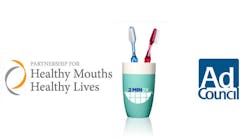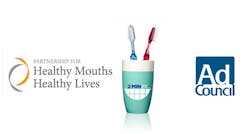Starting a nationwide conversation on declining oral health
August 16, 2012
The Ad Council has collaborated with the Partnership for Healthy Mouths, Healthy Lives to debut the public service campaign Kids’ Healthy Mouths. This is the first time the Ad Council has addressed oral health, and the campaign follows a report issued in May 2012 by the Centers for Disease Control and Prevention, which concludes that oral disease disproportionately affects children from low-income families.
According to a survey released by the Ad Council on Monday, less than half of parents report that their kids brush for the recommended two minutes twice a day. Untreated tooth decay affects 16 million children, and dentists know oral health has an impact on more than just teeth. The mouth is considered the gateway to a person’s overall health, as poor oral health is often associated with obesity, diabetes and heart disease.
According to Gary Price, President and CEO of Dental Trade Alliance, “the campaign is a groundbreaking multimedia effort that aims to educate parents and caregivers about the importance of a healthy mouth and motivate them to modify their children's behaviors through simple, low-cost, preventive strategies.” The campaign will cover an array of media outlets, including print, television, radio, Web, and social media.
The campaign stands on four foundations of good oral health care: brushing, flossing, using fluoride, and visiting the dentist regularly. The Kids’ Healthy Mouths website,2min2x.org, features music and videos designed to inspire kids to brush their teeth twice a day for two minutes. At 2min2x.org, kids can click on the “Watch & Brush” page, which features videos designed for kids up to 12 years old. There are music videos directed toward both younger children, like “The Ladybug without Spots” by Randy Kaplan, and older children, like the witty raps by Dream Jam Band, as well as Looney Tunes shorts from Cartoon Network – and that’s just the tip of the video iceberg.
Parents can also find information on the care that is required for different age groups, tips on teaching children how to brush, and information on kids’ teeth at different developmental stages. The campaign has done an excellent job at providing necessary information in an easy-to-read and accessible format, attractive to parents and children alike. 2min2x.org is available in English and Spanish, as well as a mobile version.
“We feel that, in a fun, whimsical way, we’re going to get people to think differently about their kids’ habits,” explained Priscilla Natkins, Executive Vice President and Director of Client Services for the Ad Council.
So far, the campaign has received mixed reactions from professionals. Some don’t anticipate single parents having the time to monitor kids’ brushing habits. As quoted in the New York Times, Jay A. Winsten, Director of the Center for Health Communication at the Harvard School of Public Health, said the campaign’s suggestion that parents monitor their children’s brushing habits is a “big ask for highly stressed, single-parent households.”But according to Natkins, “It’s not a question of monitoring. The premise is that kids spend hours doing inane things, and parents acknowledge this. We’re just asking for two minutes.”
As the Healthy Mouths, Healthy Lives website states, “oral disease disproportionately affects children from low-income families and these children have almost twice the number of decayed teeth that have not been treated by a dentist as compared to others in the general population.”
According to Dr. David Satcher, 41% of Hispanic children have untreated tooth decay, compared to 37% of African American children and 25% of white children. Only 55.7% of Hispanic students have a computer at home, as stated on the National Center for Education Statistics website. Compare that to 49.6% of African American students and 84.5% of white students. If almost half of the children suffering from poor oral health the most also happen to not have a computer at home, the technique of putting the education and entertainment online may not be adequate.
But the Ad Council, according to AAPD President Joel Berg, identified this problem in the planning stages and has provided a solution. “[The Ad Council] investigated the access. There is access through schools and parents … Even if there isn’t a computer at home, there is very often a mobile device. That’s the reason they made the site accessible on that format – because [smartphones] are readily available.”
Peggy Conlon, Chief Executive of the Ad Council, anticipates that the campaign’s suggestion that children watch the videos while brushing will be widely adopted.
The Ad Council is famous for its campaigns centered around social change, bringing up images of Smoky the Bear and the famous “Friends Don’t Let Friends Drive Drunk” advertisements. “The challenge is to make oral health important. Look how much interest their past campaigns have captured.” When asked if the most important thing was starting a conversation, Berg replied, “Absolutely.”
When former Surgeon General David Satcher revisited the report on oral health from 2000, he suggested that what was important was creating a conversation: people needed to be comfortable and prepared to address health issues with their doctors, but it goes farther than that – the conversation can also work to prevent health issues. As far as being a successful campaign, getting people talking about the oral health issue has to be a start, and one thing the campaign attempts to do is educate people on the power they have over their health by taking preventive measures.
“We are all about prevention. From the obesity campaign, to the campaign of children’s asthma, we’re really focusing awareness on addressing an issue before it becomes a problem,” said Natkins.
Read the press release here.
See the Kids’ Healthy Mouths YouTube channel.








